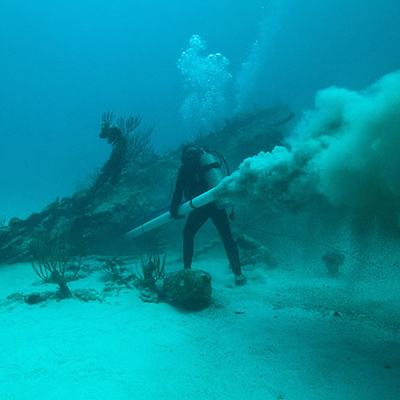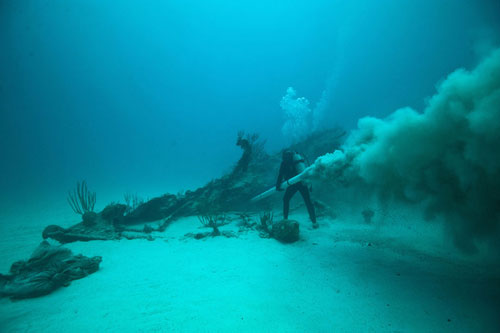
What if you could go on a digital dive to experience shipwrecks and other maritime heritage?

prior to scanning the site for a 3D computer model. (Photo
by Chris Burville) Watch a 3D video flythrough of the wreck
site.
This is exactly what a team of engineers, scientists and archaeologists are planning to make reality as they launch the Bermuda 100 Challenge, an ambitious campaign to document at least 100 ships and artifacts as well as culturally and naturally significant sites in Bermuda’s shallow reefs.
Researchers from the University of California San Diego, collaborating with the Bermuda government, nonprofit agencies and other partners in the region, aim to create a comprehensive digital atlas of shipwrecks and natural habitats in Bermuda’s waters – an historical crossroads of shipping between the United States, Europe and the Caribbean. Using advanced underwater, aerial and satellite imaging tools, the team will record the wrecks and related artifacts to construct three-dimensional digital re-creations of the archaeological sites (including 3D video flythroughs and interactive 3D computer models) without removing artifacts or disturbing the ecosystems.
On March 25 at TEDx Bermuda, UC San Diego structural engineering and computer science professor Falko Kuester officially launched the Bermuda 100 Challenge, and the island’s primary newspaper, The Royal Gazette, called it a “trailblazing project to digitally map Bermuda’s sunken treasure of shipwrecks.”
In his presentation to the TEDx conference – with Bermuda’s prime minister and other dignitaries in attendance – the structural engineering and computer science professor unveiled the Bermuda 100 website, including 3D computer models and digital video flythroughs of three shipwrecks in Bermuda’s waters: the Mary Celestia, the Blanche King, and the Montana.
“This is an interactive 3D model built off of tens of thousands of photographs, not just video,” Kuester told his audience. “We want to allow you to go there and discover it for yourself” – from a computer anywhere in the world.

the Mary Celestia after 150 years hidden by
sand. (Photo by Tane Casserley)
From the TEDx Bermuda stage, Kuester and his colleagues gave the audience a live demonstration: linking the three already-scanned wreck sites, zooming in and out of their remains on the ocean floor. The flythrough took viewers on a real-time tour of 3.5 billion data points scanned so far.
The live demo went off without a hitch, according to UC San Diego computer science Ph.D. student Vid Petrovic, a visualization researcher in CISA3-CHEI. “Just imagine that the 3.5 billion data points had to be rendered and displayed 30 times every second,” Petrovic observed. “Rendering 100 billion data points per second, points which can be freely interacted with, is unprecedented on the shoebox-sized computer we could fit into our carry-on luggage.”
Kuester called the live demo “Big Data Science at unprecedented scale” that represented the beginning of “a massive, passive sensor network, precisely capturing longitude, latitude, depth and color of site-specific information” that will be very useful in the long run for conservation. “The sensor network is providing a baseline of as-is conditions,” noted Kuester. “They will allow us to study changes at each site, including deterioration, the growth of coral, and transport of sediment, among others.”
In connection with TEDx Bermuda, the UC San Diego team and their partners in Bermuda offered a hands-on experience with the Bermuda 100 Virtual Reality Showcase between TEDx sessions. Visitors were able to chart their own 3D VR expeditions using a game controller to interact with the full-scale model on a 75-inch passive- stereo display.
Kuester – who directs the UC San Diego Qualcomm Institute’s Cultural Heritage Engineering Initiative (CHEI) and its Center of Interdisciplinary Science for Art, Architecture and Archaeology (CISA3) – is leading UC San Diego participation in the Bermuda 100 Challenge together with CISA3 Special Projects Coordinator Dominique Rissolo and Philippe Rouja, the Bermuda government’s Custodian of Historic Wrecks.
The project was conceived and initiated by Rissolo and LookBermuda director Jean-Pierre Rouja as the first phase of their collaboration with UCSD to leverage disruptive technologies for documenting and participating in conservation, exploration and educational outreach while showcasing Bermuda's cultural heritage and natural history assets as part of their Nonsuch Expeditions.
Read the complete story on the Qualcomm Institute website.
Bermuda 100 Challenge
TEDx Bermuda
Royal Gazette Article

